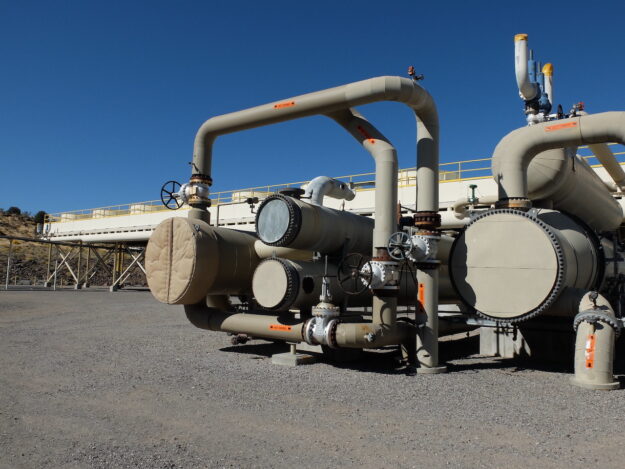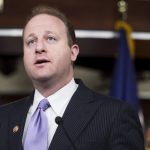Widgetized Section
Go to Admin » Appearance » Widgets » and move Gabfire Widget: Social into that MastheadOverlay zone
Polis pushes geothermal energy as new state laws kick in, industry touts technological breakthroughs

The Steamboat Hills Geothermal Power Plant in Nevada pipes steam from underground to produce power. Some states see massive potential to expand geothermal operations. Flickr/ThinkGeoEnergy
Lawmakers in some states have been laying the groundwork to add geothermal power to the electrical grid and pump underground heat into buildings. Now, a technological breakthrough could dramatically expand those ambitions — and perhaps unleash a new wave of policies to tap into geothermal sources.
Last month, a company announced the successful demonstration in the West of a new drilling technique that it says will greatly expand where geothermal plants could be built. And in the Eastern half of the country, where geothermal’s potential is mostly as a heating and cooling source, a community recently broke ground on the first utility-run thermal energy network.
Some officials say those advances show great promise. A handful of states approved laws this year and others are considering measures that would provide money and regulations to help the industry.

“There have been enormous technological breakthroughs in geothermal,” Colorado Democratic Gov. Jared Polis said in an interview with Stateline. “More geographic areas are now eligible and capable of producing inexpensive geothermal energy. You’re seeing more and more states addressing geothermal opportunities with the urgency that Colorado is.”
In the West, some states see geothermal power plants as a crucial source of “always-on” clean electricity — a resilient energy supply to bolster grids supplied by wind and solar.
At the same time, some lawmakers in Eastern states believe networks of underground heat could replace gas-powered furnaces for many neighborhoods, campuses and commercial buildings.
In both cases, supporters believe the transition to geothermal could draw on the drilling and pipeline construction expertise of oil and gas workers.
Still, it will take a lot to expand geothermal power. Exploratory drilling is expensive and uncertain, and industry leaders say government backing is required to make that initial phase manageable for companies.
Meanwhile, the drilling technique of injecting water to fracture rock has proven controversial in oil and gas operations. While geothermal projects don’t use the same chemicals that have been linked to groundwater pollution, other concerns — such as increased seismic activity — could challenge new proposals.
Unleashing potential
Last month, Texas-based Fervo Energy announced that its pilot plant in Nevada had successfully demonstrated the first commercially viable enhanced geothermal technology. Historically, geothermal power — which brings steam to the surface that powers turbines — has relied on sites with naturally occurring heat, fluid and permeable rock. Enhanced systems use oil and gas drilling techniques to create artificial reservoirs.
Sarah Jewett, the company’s vice president of strategy, said locations with permeable rock are limited and unpredictable. Horizontal drilling technology can be used to create that permeability and pump water into hotspots underground.
“This is the thing that really unleashes the potential of geothermal power, but it’s never been demonstrated on a commercial level in the U.S. before,” she said. “A lot of people said it couldn’t be done. This opens up massive new geographies [for geothermal power production].”
The plant will connect to Nevada’s grid later this year, providing 3.5 megawatts of electricity to power Google data centers. Fervo has started construction on another project in Utah that is expected to provide 400 megawatts by 2028. That’s enough to power 300,000 homes.
Geothermal provides less than half a percent of the nation’s electricity. Supporters believe that advances in technology will eventually enable it to power as much as 20% of the U.S. grid.
Fervo’s announcement could supercharge the ambitions of some Western states, which have been working to bring more geothermal power online. The Western Governors’ Association, chaired by Polis, has spearheaded an initiative on the issue and recently issued a report outlining several policy recommendations.
Industry leaders have called for clear policy guidelines and well-staffed permitting regimes, as well as public funding to support exploratory drilling, which can be financially risky for companies. They also urged more regulators to issue “clean firm” power standards such as California’s 1,000-megawatt order in 2021, which directed utilities to build out more projects from on-demand resources like geothermal.
In Colorado, lawmakers passed a slate of geothermal measures this year, including a framework for regulators to approve new geothermal operations. Under the measure, the state’s Oil and Gas Conservation Commission was renamed the Energy and Carbon Management Commission and given oversight of geothermal projects.
“They now have an expedited approval process for geothermal drilling,” Polis said. “There really hadn’t been an easy way to do that before.”
Other bills signed by Polis will create a $35 million tax credit for geothermal electricity projects and allow gas utilities to establish thermal energy networks. Lawmakers also provided funding to help Colorado Mesa University expand its geothermal heating and cooling system.
Earlier this year, New Mexico state lawmakers passed a measure to provide loans and grants for geothermal projects and a funding increase to help state regulators speed up permitting decisions. The bill sailed through the legislature with near-unanimous support, but Democratic Gov. Michelle Lujan Grisham declined to sign it, surprising backers.
“New Mexico has some of the easiest access to hot rock because of our geology, and we also have an availability of drilling rigs now in the oil and gas industry that can be put to use,” said state Sen. Jerry Ortiz y Pino, a Democrat who sponsored the bill.
Ortiz y Pino said lawmakers are hoping to meet with Lujan Grisham, address her objections and revive the bill next year. The governor, who cited fiscal responsibility in her veto of a tax credit package that included geothermal projects, did not respond to a request for comment.
Meanwhile, West Virginia leaders passed a law last year to establish a regulatory program for geothermal energy. The state has underground hotspots at relatively shallow depths compared with other Eastern states.
“We wanted to have the groundwork in place so if companies wanted to look at West Virginia, it wasn’t an unknown,” said Del. Adam Burkhammer, a Republican who sponsored the bill. “We’re not overregulating, we’re just establishing a clear path forward.”
Earlier this year, drilling began on the state’s first geothermal test well.
Thermal networks
In many Eastern states, the underground hotspots needed to produce electricity are many miles below the surface, making power production impractical with existing technology. But heating and cooling through geothermal can be achieved at much shallower depths, and many lawmakers see great promise.
“The potential is wildly exciting,” said Maryland Del. Lorig Charkoudian, a Democrat who is drafting legislation to enable geothermal heating networks. “This is a really important piece of the transition from fossil fuel to non-combusting clean energy.”
Geothermal systems bring heat from underground using piped fluids, then use a heat exchanger to transfer it to a building’s ventilation system. In warm months, the same process can cool buildings by sending excess heat underground.
Such systems are gaining momentum as a solution for individual homes and even large campuses. But Charkoudian and others want utilities to run pipelines to create thermal energy networks through towns and cities, taking advantage of an existing workforce and rate structure.
Charkoudian is drafting a bill that would allow gas utilities to build networked geothermal systems, focused first on marginalized communities. She expects to introduce the measure next year.
“When you combine super-efficient ground-source heating and cooling with a networked system, you get the most efficient way possible to heat and cool an entire neighborhood,” she said.
Such networks, she noted, also could allow high-energy users like data centers to transfer “waste heat” to nearby buildings that need it.
The push in Maryland follows a law passed in New York last year to establish a regulatory structure for thermal energy networks. New York lawmakers also voted overwhelmingly this year to expand the drilling depth for such systems below 500 feet, which backers argued was necessary to install them in dense neighborhoods.
Earlier this year, Framingham, Massachusetts, broke ground on the first utility-run geothermal network pilot project in the country.
And in Vermont, lawmakers hope to advance next year a proposal to create a regulatory structure for such thermal energy networks. As just one gas utility covers a third of the state’s area, the bill would also allow such networks to be managed by towns, nonprofits or homeowners associations.
In addition to lowering emissions, backers say the bill could help with heating prices, as rising fuel costs are a major concern in a state where nearly half of residents rely on heating oil.
“There are ways to build local [geothermal] wells and have communities own and operate their own local energy supply,” said Debbie New, lead coordinator with the Vermont Community Geothermal Alliance. “There are municipalities that are interested and saying they really need this bill to pass in order to move forward.”
Editor’s note: This story first appeared on Stateline, which is part of States Newsroom, a nonprofit news network supported by grants and a coalition of donors as a 501c(3) public charity. Stateline maintains editorial independence. Contact Editor Scott S. Greenberger for questions: info@stateline.org. Follow Stateline on Facebook and Twitter.
Alex Brown
Latest posts by Alex Brown (see all)
- Firefighters say Trump ‘driving wildfire prevention train off the rails’ by slashing federal workforce - February 18, 2025
- California air-quality battle with Trump over tail-pipe emissions looms over Colorado - January 10, 2025
- As gas taxes fall short for roads, Colorado, other states look to delivery fees - July 9, 2024


